Mermaids, pandas, and two-headed creatures

The phenomenon known as the media is arguably exclusive to modern times. Stemming from our innate human urge to communicate with others, the media have become irreversibly entangled in our everyday lives since the advent of radio and television.
As college students, we are often very aware of where to obtain anything from free food to velvet Elvis posters because of the bombardment of advertisements continuously presented to us.
Mediamerica, the current exhibition in the William and Nancy Oliver Gallery, does a remarkable job of addressing the effects of visual media on our culture, society and psychology. The exhibit is a collaborative installation featuring the work of USF College of Visual and Performing Arts alumni Motoko Hunting and Denton Crawford, as well as current Honors Painting students Daniel Mantilla, Michelle Rainey and Erica Ellis.
According to the artist statement, “Some of the aspects considered include seclusion, indifferent behavior, voyeurism, violent behavior and attention disorders.”
Mediamerica is unlike many exhibits, as the artists chose to paint and apply the majority of the images directly onto the walls of the Oliver Gallery, rather than bringing in previously finished work. Using house paint, most of which was enamel or latex, in addition to watercolor, charcoal, paper and cardboard cutouts, the group worked tirelessly for four days from Friday night to Monday night.
“We kept our color schemes simple and somewhat similar to create a sense of unity throughout the gallery,” Crawford said. “In the end, it felt like one gigantic
collaborative painting.”
The
figures presented vary in size – some are only a few inches high while others span the entire height of the wall, approximately 15 feet. When entering the gallery, the first image the viewer encounters is a delightful painting of a bald, elderly man sitting on a long couch, gripping a drink and a cigar and donning a deliciously tacky pink, white and black leisure suit. The elderly figure, one of the larger in the collection, wears dark glasses and appears to stare straight ahead, above the heads of the viewers. His slightly slouched posture and relaxed position are suggestive of a couch potato.
Moving around the rest of the exhibition, the audience is presented with images that reflect the different artistic styles of their creators. Some images, such as the large female figures dressed in Victorian costumes, are beautifully executed using clean lines and solid, crisp colors. Other figures, such as the one with two faces and a disproportionate number of limbs, are less colorful and incorporate a sketched style of painting.
Figures are shown engaging in violence and voyeurism. Fantastic images of mermaids, one docile and relaxed while the other is bent backward in turbulent motion, adorn the walls next to smaller, adorable images of pandas. The variety of images depicted may seem erratic and unrelated at first glance. However, upon considering the oversaturation of images present within the American media, their significance becomes more apparent. Considering this exhibit in a larger context, it seems the random presentation of ‘a bunch of stuff’ is precisely indicative of the media collectively.
Overall, the quality of the work is admirable, with all participants exhibiting excellence in technical skill and creativity.
Mediamerica takes a collaborative look at the effects of the American media’s unyielding bombardments on society with a fanciful and honest eye.
The show is on display at the William and Nancy Oliver Gallery until Friday, Sept. 21. A closing reception takes place Friday night from 7 to 9.






